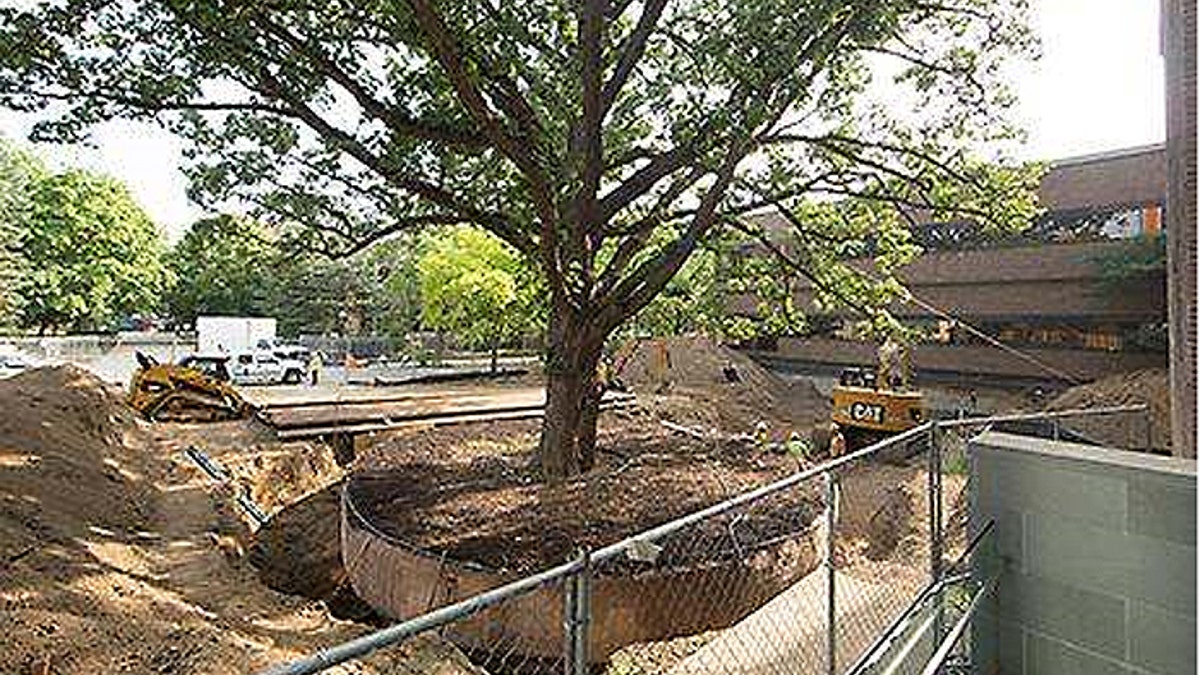
The burr oak has stood for as long as 300 years, but now it is in the way of an expansion of the University of Michigan's business school. (Courtesy: University of Michigan)
A decision by the University of Michigan to spend $400,000 to relocate a centuries-old oak tree in the way of a planned business school expansion has critics on campus and at arch-rival Ohio State stumped.
The 350-ton burr oak is being moved to make room for a new building at the Ross School of Business, according to University of Michigan spokesman Rick Fitzgerald. Experts will use a newly patented technique dubbed "Arborlift" involving oil well drilling equipment and air bladders to hoist the 44-foot-in-diameter rootball from a hole already dug around the tree, then hauled one city block and replanted. They figure the tree's chances of survival top out at 70-80 percent.
[pullquote]
“It’s very much like the Egyptians moved the blocks for the pyramids,” said Tom Cox, founder of Environmental Design, which was hired to handle the task. “The driver of the cost is the amount of weight being moved. When you move things that are 700,000 pounds - which is equivalent to moving 300 average size cars at the same time - that’s what’s driving the cost of it.”
Although the pricey planting is covered by donations, it nonetheless comes at a time when the university is increasing in-state tuition 1.6 percent and out-of-state tuition 3.4 percent. That has some students complaining it is a waste of money.
“It may have been the same price to redo the building plans and it would have certainly taken a little bit longer, but then we wouldn’t have lost this huge asset,” said Pete Widin, Landscape Architecture Masters student at the university's School of Natural Resources & Environment.
But the cost of uprooting the tree is nothing compared to the $100 million donated by Wolverine alumni and Miami Dolphins owner Stephen Ross to sponsor the renovation. Other donors kicked in another $35 million.
At The Ohio State University, Michigan's arch-rival on the gridiron, fellow arbor academic Jim Chatfield, Associate Professor at the Department of Horticulture & Crop Sciences and Department of Plant Pathology, called the effort "inspiring." But he said the effort - not to mention money - spent to save one tree might have gone farther if focused on training a new generation of tree-huggers in the importance of urban forestry.
"U of M obviously has a number of Loraxes inspired to stand up and speak for this tree," said Chatfield, associate professor at the Department of Horticulture & Crop Sciences and Department of Plant Pathology. "In the long run, the deeper issue is growing our understanding of how trees matter so that monetary and human resources to sustain healthy urban and campus forests are provided on campuses nationwide every day of the year."
Before construction on the tree started, Widen started a petition called “Save The Oak” that was signed by 300 U-M students, faculty and staff to keep the tree in its place.
University of Michigan Landscape Architecture Professor Bob Grese was one of the faculty members who signed the petition and said society runs the risk of losing a connection with nature.
“There’s clearly a lot of studies that show the kind of attached fascination of watching the leaves blow in the wind and watching squirrels hop along tree branches," Grese said. "Those things restore our mental freshness and help us recover from stressful parts of our lives.”

